Oyster Mushrooms

Pearl oyster mushrooms
Why grow Oyster Mushrooms?
Oyster mushrooms are among the most popular choices for home, hobby and commercial growers alike, and with good reason. They can be grown on practically any type of substrate and, because they’re among the easiest mushrooms to grow, they’re perfect for those just starting out growing mushrooms. What you learn while growing Oyster mushrooms will stand you in good stead when you start growing fussier varieties.
Oyster mushrooms can be found in the wild. They grow on dead or decaying logs in temperate and tropical forests. They were first cultivated by a German scientist in 1917 and are now the third most commonly cultivated mushroom in the world, most often grown in China.
Oyster mushrooms are available in a wide number of varieties, including yellow, pink, blue and grey.
Learning how to grow oyster mushrooms is a crucial skill for anyone wanting to get into the hobby of mushroom cultivation. Once you know how oyster mushrooms are grown, you can use those skills to foray into all other areas of mycology and mushroom cultivation.
Health benefits
Oyster Mushrooms are sometimes called a superfood. Why? Well, for those who are interested, they contain many health and immune boosting compounds including beta-glucans and polysaccharides. They are a great source of protein, thiamin, vitamin B6, folate, iron, magnesium, zinc and manganese, plus dietary fibre, riboflavin (B2), niacin (B3), pantothenic acid (B5), phosphorus, potassium and copper. If Oyster mushrooms are grown in sunlight, opposed to artificial light, they can also absorb vitamin D. That’s quite a list of benefits and it isn’t a recent revelation; oyster mushrooms have been used for thousands of years in traditional Chinese medicine as a tonic to support a healthy immune system and also treat a wide range of ailments.
Oyster mushrooms are a great source of antioxidants, including ergothioneine, which is uniquely found in fungi and unlike other antioxidants, is not destroyed by heat during the cooking process. Antioxidants in oyster mushrooms also help to clean up free radicals which have been linked to cancer. Oyster mushrooms contain compounds such as beta-glucans and guanidine which naturally help to lower blood sugar and combat diabetes and related Cardiovascular diseases. On top of that, studies have shown that oyster mushroom has anti-inflammatory proprieties due to its ability to inhibit certain signals associated with inflammation.
What’s more, they also taste good!
Oyster mushrooms have a subtle seafood flavor with hints of anise and a faint, earthy taste. Cooked oyster mushrooms bring a soft, meaty texture to soups, stir-frys, and salad recipes. Because their flavor is mild, without the strong earthiness of some mushroom varieties, they work well in a range of different dishes.
Here are a few ways to incorporate oyster mushrooms into your diet:
- Add them to soups and stews.
- Cook and add them to pasta and grain dishes.
- Sauté them with olive oil and garlic for a nutritious side dish.
- Chop and add them to sauces and gravy.
- Use them in egg dishes like frittatas, omelets, and quiches.
- Grill them on skewers with vegetables and a protein source like shrimp or chicken.
- Roast them in the oven.
Which strain of Oyster Mushroom?
Before you can start thinking about growing Oyster mushrooms, you first have to decide exactly what species you want to grow.
The right species for you will depend on a number of things- where you live, what method you plan on using for cultivation, and your experience level.
Blue Oyster (Pleurotus ostreatus var. columbinus)

Blue oyster mushrooms
Positives: Good for cooler temperatures and fast growing
Negatives: Need lots of fresh air for ‘normal-looking’ mushrooms
The Blue Oyster mushroom is arguably the most handsome Oyster strain and an excellent choice for new growers. The Blue Oyster is well suited to cooler temperatures and the colder the temperature during fruiting, the more blue the mushroom will be. That said, the blue colouration is most visible in the early stages of growth, then turns to grey as the mushroom matures.
Blue oysters are ideal candidates for outdoor growing as their fresh air requirements are among the highest of all mushrooms.
Yellow Oyster (Pleurotus citrinopileatus)
Positives: Lovely yellow colour, fast growing and high CO2 tolerant
Negatives: Delicate mushrooms (breakable) with a short shelf life so must be consumed when fresh, average flavour
The Yellow Oyster produces beautiful but very delicate “bouquets” of thin capped yellow mushrooms. They also smell distinctly like citrus fruit when fresh. The yellow oyster is fast to fruit and easy to grow, being much more tolerant of low fresh air intake than many other types of Oyster. These generally grow a little better on a hardwood sawdust and bran substrate.
Unfortunately, the yellow color is lost during cooking, and the flavor of yellow oysters is nothing special. Also, yellow oysters have a very short shelf life and will only last a few days in the fridge before they start to smell – some say a bit like urine! These need to be enjoyed as fresh as possible – we’d say the same day as they are harvested.
Pink Oyster (Pleurotus djamor)

Pink oyster mushrooms
Positives: Striking pink color, nice thick fruits, easy to grow on straw, heat tolerant
Negatives: These have a short shelf life, and can die in cooler temperatures
The Pink Oyster is a very striking and beautiful mushroom. The vibrantly pink mushrooms grow out in huge floral bouquets and are typically snapped up double-quick when for sale in speciality and farmers markets. The fruits are usually large, and much less delicate than yellow oysters. Pink Oysters are very heat tolerant and can be grown where grow room temperatures exceed 30 deg C.
Unfortunately, cold temperatures can easily kill the mycelium of pink oysters, which makes it a troublesome species when it comes to storing spawn or cultures in the fridge. Similar to yellows, pink oysters have a very short shelf life and will only last a few days in the fridge. For this reason, they need to be consumed (or sold) almost immediately after harvest.
Elm Oyster (Hypsizygus ulmarius)
Positives: These are well adapted to high CO2 levels, offer high yields and low spore loads
Negatives: You could say a lack of a striking colour, plus they have a short shelf life
Elm Oysters are not really oyster mushrooms because they’re not in the “Pleurotus” family, but they are a closely related cousin and most growers refer to them as oysters anyway. However, they have a few advantages over most other Oysters that make them worth considering. The Elm Oyster is much better at forming ‘normal looking’ fruits in high CO2 environments, which means it’s great for indoor growers, in particular in grow rooms that struggle to supply the high levels of fresh air required by other Oysters. It also has a lower spore load than most oysters, which can save time spent cleaning up and clogged fans.
The Elm Oyster is a white-beige colour, and forms nice large caps in dense clusters. It grows well on hardwood sawdust substrates, is fast to colonize, and very tolerant of beginner growers.
Pearl Oyster (Pleurotus ostreatus)
Positives: These are readily available, easy to grow, have a decent shelf life, and good to cook and grow on many substrates
Negatives: Like most oysters, they have a high fresh air requirement
The pearl oyster is the “standard” oyster mushroom, grown all over the world. Pearl Oysters grow quickly and fruit heavily – giving very good crops. They will grow on a variety of substrates, including hardwood sawdust, hardwood chips, wheat straw, oat straw, grass clippings, coco-coir and more. Pearl oysters have a decent shelf-life, better Pinks or Yellows for example, but not as good as King Oysters. Apart from having a high fresh air requirement, pearl oysters are one of the easiest to grow, which is why they feature in so many mushroom growing kits.

King oyster mushrooms
King Oyster (Pleurotus eryngii)
Positives: These have the best shelf life among oysters, are versatile and have a meaty texture
Negatives: King oysters can suffer from ‘bacterial blotch’ if humidity is not carefully managed.
King Oysters different to other oysters, which grow in clusters, because the fruits typically grow singly instead. They can sometimes resemble button mushrooms. If grown in high CO2 and low light conditions, king oysters will form big fat stems and relatively tiny caps. Commercial growers favour this technique because the stems of king oysters have very good texture and flavour, which makes them good sellers. If king oysters are grown in low CO2 and well-lit conditions they will instead form large dark caps, making them look a little like portobello mushrooms. King oysters have the longest shelf life of all oyster mushrooms and can sometimes last for up to two weeks in the fridge.
King oysters are usually grown on a sawdust substrate to get higher yields, but will also grow on straw. King oysters are fussy about humidity levels and can develop “bacterial blotch” if levels are wrong.
Substrates for growing oyster mushrooms
Each variety of oyster mushroom has its own preferences but on the whole, the best substrates for Oyster mushroom cultivation are:
Hardwood (sawdust or pellets)
Straw (chopped or pellets)
Soya Hulls (pellets)
Sunflower husks (pellets)
Coffee grounds
Generally, when it comes to straw and hardwood, using pellets is less messy and easier than working with loose chopped straw or bags of sawdust.
